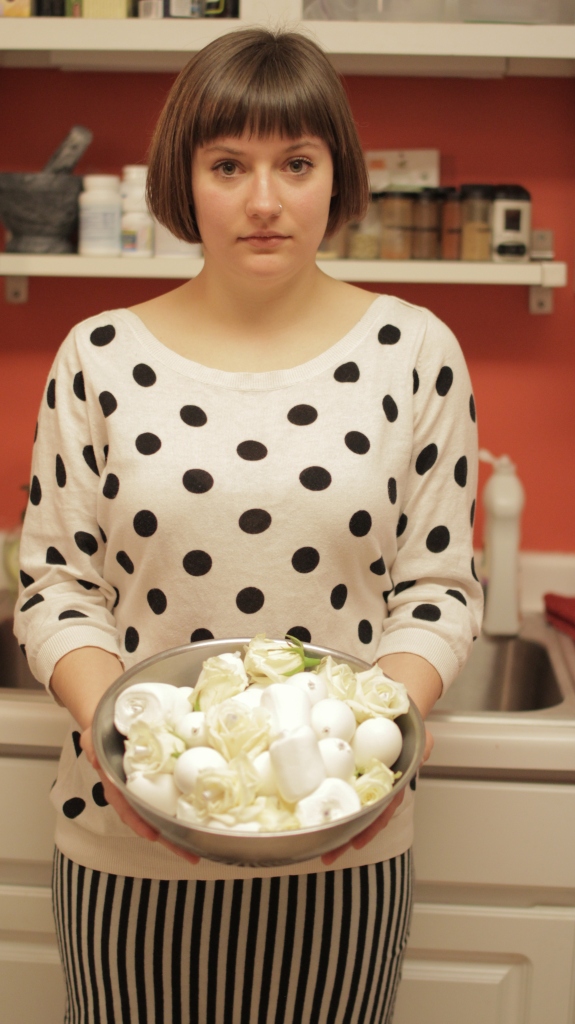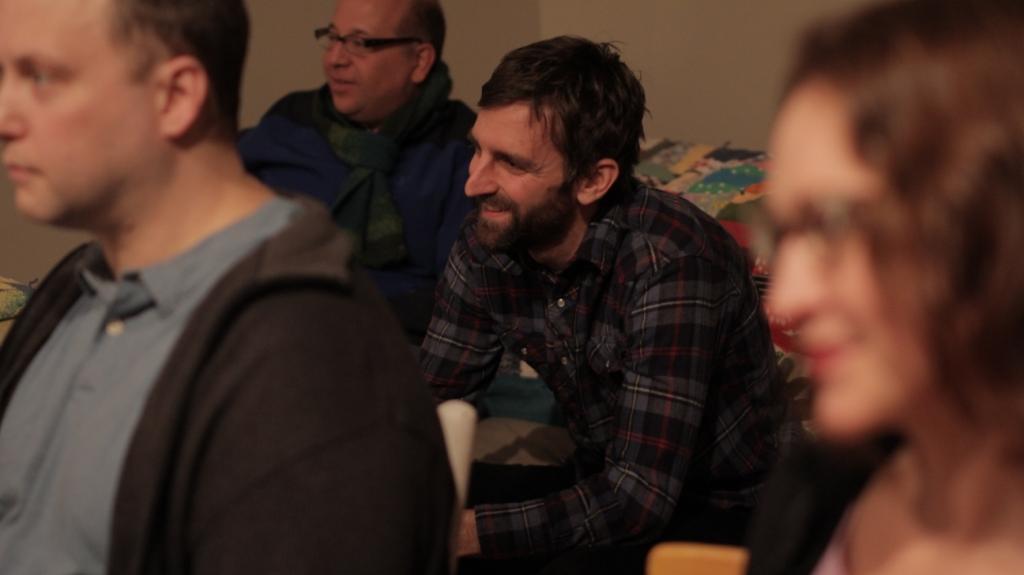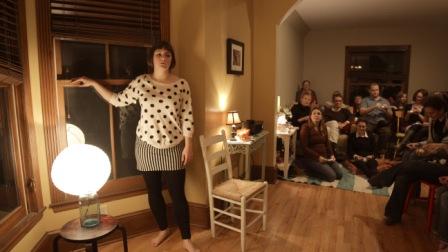Out of Context: the week in dance
Lightsey Darst reports back from a dance she saw recently, out of the usual context of stage and theater and situated instead in a private living room alongside performances of poetry, music and informal audience participation.



“I NEED TO DO AN ARM CHECK,” Emily Gastineau says, angling her limbs out to see if she has enough space in Laura Holway and Ben McGinley’s dining room. “An art check?” someone mishears, eyeing a couple of ceramic pigs. Gastineau windmills. People are scattered here and there and piled on a couple of old couches, waiting to see Gastineau dance. She’s the third of three acts at this art party, following up Kristen Graves singing her own songs and Brad Liening reading his poems.
Gastineau says a little about the dance she’s about to do. It’s Deborah Hay’s instructions crossed with somebody else’s something and mixed in with some other ideas; it’s complicated, I lose track. The dance itself is simple, though: Gastineau rings changes on windmilling and swinging her arms for seven minutes or so, standing in one place the whole time.
I’ve been keeping tabs on Gastineau for a little while, noting her ambition and intelligence, but mostly unconvinced by the flesh of her dancing, by the experience of it. This intimate setting works for her, though. This close, there’s no avoiding her materiality: She breathes, her breathing quickening and slowing with the intensity of the dance, and she creaks—an alarming joint sound that turns out to be just her bra strap snapping. She’s younger and smaller up close than she appears on stage, and her bobbed hair is very shiny; I watch it switching back and forth, fluffing and settling. She said before the dance began that people have told her “You don’t look like you’re there when you’re dancing,” and she took that comment as a challenge, a dare. The counterintuitive result is that she’s more there than usual this night. Her shifts in speed and emphasis matter. Normally such small changes might bore me, but I track them here, even noting when she leaves one move too quickly.
How strange: I’m very close, maybe five feet away, from this person engaged in a physical transformation driven by its own internal logic. It’s like standing beside a whirling dervish, or like being onstage. My sitting feels like its own set of choices instead of a default. And knowing I was going to see a dance also colored what came before: I noticed the three-dimensional shape of Graves’s guitar, its body, and Liening’s rhythmic rocking, a metronome against the syncopation of his reading.
Gastineau sets up for another dance. Here we in the party, in the little audience, have a task. We pass around a bowl of boiled eggs, snipped white rose heads, and marshmallows, taking one as the bowl passes. Each has a rolled-up paper stuck into it, and our job is to read what’s on the paper when we like. Gastineau reacts; as far as I can tell, each statement cues a motion that Gastineau blends in as the statement is read. But the dance is not so much the dance; it’s everyone passing the bowl, it’s pulling out a rose or a fluffy marshmallow or a chilly egg, unrolling the paper, listening to others, choosing, reading.
______________________________________________________
The dance is not so much the dance. It’s everyone passing the bowl, it’s pulling out a rose or a fluffy marshmallow or a chilly egg, unrolling the paper, listening to others, choosing, reading.
______________________________________________________
Usually I write about dance onstage — distant, isolated. It’s different when you put dance next to other things—poetry, music, party chitchat, ceramic pigs. It’s also different when you put other things next to dance.
Today I’m watching Ananya Dance Theatre rehearse. The company is nine months from their next new work, so the rehearsal is not a series of dances; it’s a yoga/Odissi class (which I take), about twenty minutes of practicing a short phrase, and, after noon, two hours of talk. The dancers sit in a circle on the floor around a communal lunch and listen to women talk about water. That’s the subject of their next performance. How do you make a dance about water? Research and magic. The poet Wang Ping talks about rivers, about paddling the lower Mississippi, touching her belly as she remembers the work. A scientist speaks about estuaries, about how fresh and saltwater mix, about extinct river dolphins. An organizer relates her grandmother’s story about standing outside naked in the first rain of the year in Ethiopia. Another young Somali woman tells how in Kenya, in her refugee camp, her well was called “the well of blood” because of the fighting over water. She’s laughing as she recalls being eight and having scratches on her cheeks all the time from defending her family’s place in line.
We stretch forward from our places in the circle, one after another, to get food: clementines, string cheese, raw almonds. All the voices are women’s voices. We talk about salmon and nomadic people, water in the human body, what would happen if you drank too much saltwater. I remember growing up in Florida, going outside in a swimsuit after the lightning was over to “swim” in the rain. The young woman from Somalia tells us that when the refugee camp caught fire, there was nothing you could do but run. When it rained, you’d get out anything that could hold water, go outside, and dance. Everyone’s feet are still ringing from the morning’s work. The dancers take notes. Ethiopia wants to dam the Nile. People downstream don’t get a say in what happens upstream. You can put this into a dance. You can dance this too.
______________________________________________________
About the author: Originally from Tallahassee, Lightsey Darst is a poet, dance writer, and adjunct instructor at various Twin Cities colleges. Her manuscript Find the Girl was recently published by Coffee House; she has also been awarded a 2007 NEA Fellowship. She writes a weekly column on dance for mnartists.org.